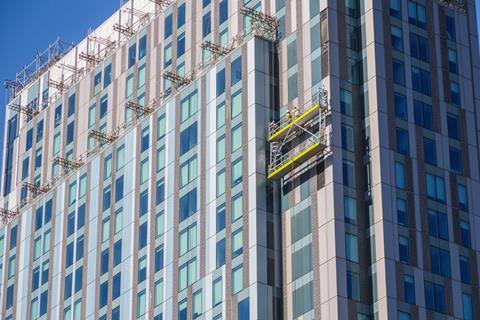Move designed to free up housing market by exempting flat blocks without cladding from need for fire assessment
The RICS has published updated guidance aimed at restricting the need for house valuers to use EWS1 forms to assess the fire safety of housing blocks, following a consultation at the start of the year.
The guidance is the result a deal agreed with the government last November designed to help an estimated half a million flat owners by ensuring that blocks without cladding systems are not caught up in the fallout from the Grenfell Tower fire, which has left many facing huge repair bills and unable to sell their homes.

However, the RICS has changed part of the new guidance in response to evidence received in the consultation, with a revision that is more specific about the situations in which buildings with balconies will need assessments.
The new guidance means that no flat blocks without either cladding or vertically stacked balconies containing combustible material should be required to undertake an EWS1 assessment. In addition, all buildings of four storeys or fewer – even if they have cladding and balconies – will also be exempt, unless their cladding consists of the most flammable ACM, MCM of HPL panels.
The guidance is seen as essential in helping to free up the housing market for high rise buildings after the introduction of the EWS1 assessment, which mortgage lenders and insurers have started requiring on all flat sales, regardless of height or fire risk, leading to a logjam as there are not enough trained assessors able to undertake the assessments.
The idea is the guidance will give mortgage lenders and insurers confidence enough not to request EWS1 forms where not necessary as a condition of lending or offering cover.

Housing Secretary Robert Jenrick (pictured) welcomed the guidance, which he said would mean nearly 500,000 leaseholders will no longer need an EWS1 form. He said: “Backed by nearly £700,000 Government funding, almost 500 assessors have now started training so that where valuations are needed these can be done more quickly, speeding up the process for homeowners.”
The RICS said 492 assessors were currently undertaking the EWS assessment training course.
Ben Elder, RICS’ head of valuation standards, said that the “majority” of mortgage lenders were signed up to the guidance, which will come in to force on April 5, and called on the rest to sign up. He said: “This guidance provides a framework for consistency across the mortgage valuation sector as to when an EWS1 form is required.
“We have reached our final position following very careful consideration of the evidence to ensure that buildings at higher risk of remediation work are appropriately investigated in the valuation process, to support reliable advice by valuers to their lender clients.”
The RICS said it had amended the guidance since its January consultation “in the light of the evidence received during the consultation” in order to “provide appropriate protection for lenders and purchasers”.
Previously it had proposed that buildings of five or six storeys without a significant amount of cladding or any ACM, MCM or HPL panels were to have been exempt from the requirement to undertake an EWS1 assessment as long as they didn’t have vertically stacked balconies.
The guidance now says such buildings can avoid the need for an assessment even where they have vertically stacked balconies, as long as either both the balustrades and decking are constructed with non-combustible materials, or – where the balustrades are non-combustible – the balconies are not directly linked by combustible materials.
The publication of the guidance follows the government’s pledge to spend £5bn supporting the remediation of flat blocks affected by the post-Grenfell fire safety crisis, and has pledged to bring in a developer levy to pay for the funding. The Labour Party has called for more funding, amid estimates the true cost of the problem could be in the region of £15bn.
An analysis by the Labour Party said that problems related to fire safety work could be affecting up to 11 million people in 4.6 million properties.
Specifically, the guidance states than an EWS1 form should be required by lenders in the following circumstances:
For buildings over six storeys where:
- There is cladding or curtain wall glazing on the building or
- there are balconies which stack vertically above each other and either both the balustrades and decking are constructed with combustible materials (e.g. timber) or the decking is constructed with combustible materials and the balconies are directly linked by combustible material.
For buildings of five or six storeys where:
- There is a significant amount of cladding on the building (for the purpose of this guidance, approximately one quarter of the whole elevation estimated from what is visible standing at ground level is a significant amount) or
- there are ACM, MCM or HPL panels on the building** or
- there are balconies which stack vertically above each other and either both the balustrades and decking are constructed with combustible materials (e.g. timber), or the decking is constructed with combustible materials and the balconies are directly linked by combustible materials.
For buildings of four storeys or where:
- There are ACM, MCM or HPL panels on the building**.
For more details on the new guidance, see here.










No comments yet